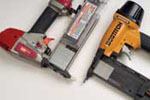- Craftsman and Ridgid allow you to switch from single-fire to bump-fire sequencing, though I’m not sold on the need to bump-fire a pin nailer on precision work.
- Makita and Ridgid have an attached, adjustable belt hook. Makita’s requires a tool to switch the hook direction either left or right while Ridgid’s ratchets around on detents to any position you like–very nice. Senco sends its multi-tool hook with the tool.
- The Craftsman, Max, and Ridgid tools have non-marring rubber pads built into the side that protect the tools and workpieces when you set the tools down.
- Max and Ridgid put a great swivel hose attachment on their tools to keep hoses tangle-free.
- Craftsman, Max, Ridgid, and Senco provide space on their tools for storage of extra nose tip attachments and/or Allen wrenches for tool adjustments.
- Senco has a power switch. Flip this and get 30 percent more power. Nothing I nailed, however, required this feature.
- Max and DeWalt each have a lock-out lever on the tool that prevents kids or curious folks from picking the tool up and firing it.
- Craftsman and Ridgid allow you to switch from single-fire to bump-fire sequencing, though I’m not sold on the need to bump-fire a pin nailer on precision work.
- Makita and Ridgid have an attached, adjustable belt hook. Makita’s requires a tool to switch the hook direction either left or right while Ridgid’s ratchets around on detents to any position you like–very nice. Senco sends its multi-tool hook with the tool.
- The Craftsman, Max, and Ridgid tools have non-marring rubber pads built into the side that protect the tools and workpieces when you set the tools down.
- Max and Ridgid put a great swivel hose attachment on their tools to keep hoses tangle-free.
- Craftsman, Max, Ridgid, and Senco provide space on their tools for storage of extra nose tip attachments and/or Allen wrenches for tool adjustments.
- Senco has a power switch. Flip this and get 30 percent more power. Nothing I nailed, however, required this feature.
Cool Features
Several of the tools in the test come with unique features that may be helpful on site:
- Max and DeWalt each have a lock-out lever on the tool that prevents kids or curious folks from picking the tool up and firing it.
- Craftsman and Ridgid allow you to switch from single-fire to bump-fire sequencing, though I’m not sold on the need to bump-fire a pin nailer on precision work.
- Makita and Ridgid have an attached, adjustable belt hook. Makita’s requires a tool to switch the hook direction either left or right while Ridgid’s ratchets around on detents to any position you like–very nice. Senco sends its multi-tool hook with the tool.
- The Craftsman, Max, and Ridgid tools have non-marring rubber pads built into the side that protect the tools and workpieces when you set the tools down.
- Max and Ridgid put a great swivel hose attachment on their tools to keep hoses tangle-free.
- Craftsman, Max, Ridgid, and Senco provide space on their tools for storage of extra nose tip attachments and/or Allen wrenches for tool adjustments.
- Senco has a power switch. Flip this and get 30 percent more power. Nothing I nailed, however, required this feature.
